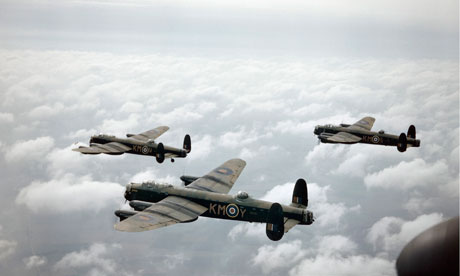
Few hostages have been offered up so eagerly to fortune. In 1864, Victor Hugo wrote to the balloonist and pioneer aerial photographer Félix Nadar in praise of Nadar's experiments with heavier-than-air flight. The aeroplane, thought Hugo (who should have known better), would surely mean an "instantaneous, universal and perpetual abolition of frontiers. Armies would vanish … It would be an immense peaceful revolution." It was not.
Aerial bombardment, unthinkable to Hugo, was under way by 1911 and has never gone out of fashion. The German bombing of Guernica during the Spanish civil war set the pattern, prompting British poets to imagine a near future of death from above. "The grey bomber has set limits to the air," wrote HB Mallalieu, as if to answer Hugo's optimism. "Spain has changed the contours of the Earth, / Imposed new frontiers though geography has grown."
In 1943, Daniel Swift's grandfather was shot down and killed in one of those grey bombers, a British Lancaster attached to 83 Squadron, Bomber Command. Strictly speaking, "bomber county" is Lincolnshire, where dozens of makeshift airfields dotted the wartime landscape, but in Swift's imagination it extends as far south as Wyton in Cambridgeshire, where his grandfather's final flight began. In Bomber County, Swift sets out both to reconstruct the final moments of a life, and to counter the long-standing assumption that the second world war produced no great poetry.
The division of spoils is supposed to be neat and equable: the Somme was fought in verse, Dunkirk abandoned in prose. Owen, Sassoon and Rosenberg give way to Mailer and Heller and Waugh. Swift begins from the poet Robert Graves's prediction, in 1941, that "no war poetry can be expected from the Royal Air Force". The common feeling was that the mechanised war machine was ruinous to the writing of verse, and though Graves was wrong it would be a mistake to judge him too harshly. He was not the last old soldier to underestimate the RAF.
His mistake was to judge the second world war according to the standards of the first. As the South African poet and soldier RN Currey has pointed out, the best-known poets of the second world war were army men like Sidney Keyes, Alun Lewis and Keith Douglas, who fit the ideal of the front-line fighter established in a previous generation by Owen and Sassoon. The bomber, it was thought, mechanical and detached, could never approach their terrible knowledge.
To Swift, on the contrary, there is "a special kinship between poetry and bombing". The air crew's story is a version of the oldest epics of battle: the British bomber pilot is both the soldier of The Iliad, burning the topless towers, and Odysseus, struggling against the odds to make it back to his island home. The trouble with Bomber County is that its thesis isn't borne out by the poets Swift chooses to rescue from oblivion. For the most part, the sections of the book that deal with literary history concentrate on well-known writers, with sensitive readings of Dylan Thomas, Randall Jarrell, Eliot and Auden. By returning to those canonical figures Swift undermines his own contention that the poetry of the bomb remains "a hidden tradition". This is a pity, because his thesis is sound. The poetic response to air war was rich, and a vast body of neglected work by bombers and, especially, by the bombed, gives the lie to the idea that poetry was silent about the Blitz.
Swift, on the other hand, is silent about Guernica – arguably the first bombing campaign of the war. He is silent about bombed poets like David Gascoyne and Hubert Nicholson and Suzanne Knowles, and silent about E Denyer Cox, Herbert Corby and Edward Field – poets and pilots all. Instead, he chooses to honour "three lost airmen" whose verse can be found in the archives of the Imperial War Museum.
As a tribute to these three men – and to James Eric Swift – Bomber County is touching and admirable. Nonetheless, to say that the verse of Michael Scott, Frank Blackman and John Riley Byrne is deservedly forgotten is not to diminish their bravery or to denigrate the memory of a sacrifice. If we value poetry as something irreducibly human reclaimed from the ashes of an inhuman conflict, then we need above all to remember the poets whose writing records most fully and responsively the pressures under which they fought and wrote and died. In that respect, Bomber County is a missed opportunity.
It is not difficult to understand why Swift should want to reclaim the poems he has found in the rubble. The words can be brought back, and previously unheard voices can speak between the lines of the letters and the dry records that tell the story of his grandfather's life and death. But when Swift writes of Mervyn Peake's The Rhyme of the Flying Bomb that there is "a music to this damage: a balance to the loss of bombing", it is clear that he hasn't attended closely enough to the aesthetic legacy of the bombs, or to the ethical conflict between the physical destruction of cities and the transformation of that destruction into art.

